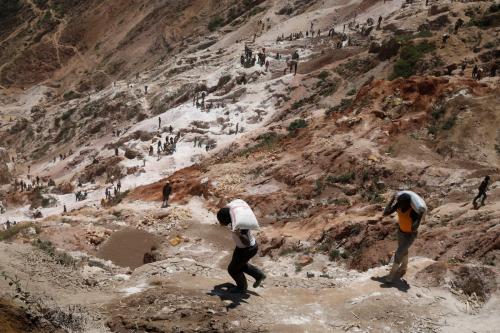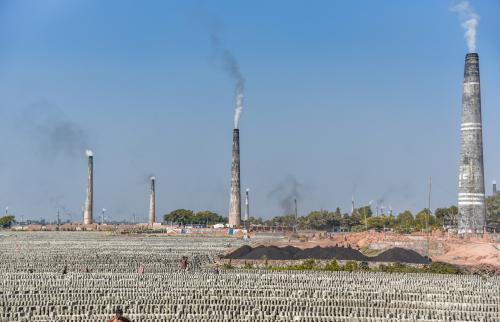Climate change is expected to increase the number of sudden-onset disasters caused by natural hazards and as a consequence we can expect more disaster-induced displacement around the world. As experts gathered last week for a meeting of the KNOMAD working group on environmental change and migration, it was clear that while there is much that we know, there is even more we don’t know about the nature of such displacement.
Some things we know:
- Thanks to the good work of the Internal Displacement Monitoring Centre (IDMC), we know that large numbers of people are displaced every year due to sudden-onset disasters (32.4 million in 2012), that most such displacement is due to weather-related events (98% in 2012), that in the last five years or so 80% or so of these displacements occurred in Asia. We know that most displacement occurs within national borders and that disaster-induced displacement can be protracted (as in the Philippines, where reports are that 2 million are still displaced 7 months after Typhoon Haiyan).
- We also know that displacement from disasters is increasing and is likely to increase in the future. According to IDMC, 144 million people were displaced by sudden-onset disasters in the last five years. One of the perhaps unheralded success stories of the past few decades has been the dramatic decrease in fatalities associated with sudden-onset disasters. While the figures vary from year to year, trends over the past twenty years indicate that more people are being affected by disasters and economic costs of property damage are increasing but fewer people are dying. When people survive, but their homes are destroyed, they are displaced.
- Displacement from sudden-onset disasters is likely to increase in the future as a result of the effects of climate change. The Intergovernmental Panel on Climate Change has reported that sudden-onset disasters related to weather are expected to increase in intensity and unpredictability. However, we should also note that climate change may bring an increase in sudden-onset disasters that do not displace large numbers of people, like heat waves which have received relatively little attention from researchers or the humanitarian community (remember that some 70,000 people died in Europe in 2003 as a result of a heat wave). But heat waves generally don’t destroy property or displace people.
- While the Guiding Principles on Internal Displacement offer a normative framework for those who are internally displaced by disasters, the solutions for those displaced by disasters may differ from those displaced by conflict or other reasons, particularly when a community is destroyed or rendered uninhabitable because of the disaster – e.g. landslides, earthquakes.
- While most countries have a legal framework for disaster response (and increasingly for disaster risk reduction), laws on disasters have (so far) not incorporated the Guiding Principles. And yet, there are clearly human rights issues associated with disaster-induced displacement, such as increases in gender-based violence in temporary shelters, discrimination in assistance and solutions, shortcomings in evacuation procedures, etc.
What we don’t know:
- While we have some overall estimates of the number of those displaced by disasters, we know very little about patterns and cycles of displacement. Governmental tracking systems are inadequate – particularly for those who are displaced and do not go to official shelters. Different governments use different indicators and systems for capturing figures on displacement. Are people displaced multiple times? Where do people go after they leave temporary shelters when they can’t return home? What happens to renters? What is the impact of displacement on receiving communities? The recent report by IOM/IDMC on displacement six months after Typhoon Haiyan suggests that significant number of those displaced are off the radar screen, staying with relatives or renting accommodations. We simply do not know about the patterns of disaster-induced displacement.
- A second area where we lack knowledge is on the particular challenge of displacement when disasters occur in urban settings. How can/should policies toward the displaced relate to the urban poor whose housing may have been damaged but who have not had to move? What are the particular needs of squatters? Can people be displaced if they had no fixed abode before the disaster? What do solutions mean in urban settings?
- There is a lack of clarity in the distinction between sudden and slow-onset disasters. Clearly an earthquake is a sudden-onset disaster, occurring in the course of a few minutes, with seconds – or tens of seconds of warning. A drought that develops over the course of a year is clearly a slow-onset disaster, but there’s a gray area between sudden and slow-onset disasters. For example, Pakistani floods in 2010 developed over the course of 3 months – was this a slow or sudden-onset disaster? Are wildfires that develop over weeks – or a heat wave – a slow or sudden-onset disaster? These distinctions should matter when it comes to preparedness and response (national and international response systems should be better with 3 months to prepare than 30 seconds). But how do or should they affect response to displacement? We also should devote more attention to the intersection between sudden and slow-onset disasters, both of which will be exacerbated by climate change. For example, as Robin Bronen has pointed out, stronger storms are increasing coastal erosion in Alaska, making areas uninhabitable.



Commentary
Disasters and Displacement: What We Know, What We Don’t Know
June 9, 2014